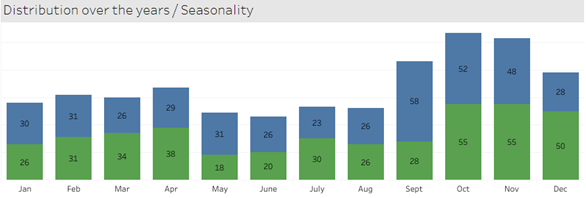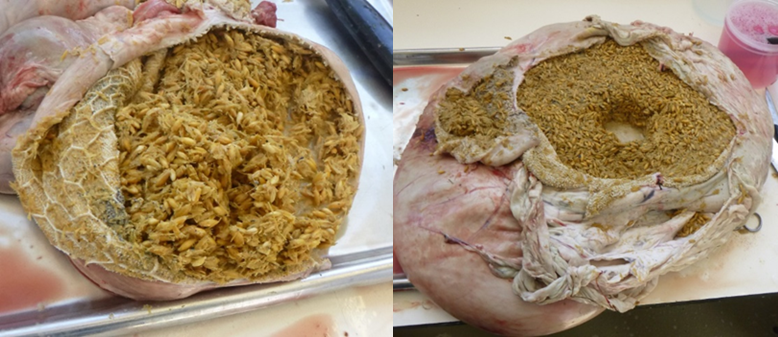Ruminal acidosis
At this time of year, it is not uncommon to see cases of ruminal acidosis, this is often due to dietary changes associated with reduced grazing or housing. The graph below shows the seasonal distribution of diagnoses over the last ten years.
UK cases of ruminal acidosis in cattle (blue) and sheep (green) diagnosed 2014-2024, showing seasonal trend (APHA/SRUC Enhanced Disease Surveillance Dashboard, accessed 13/11/24)
A recent submission diagnosed ruminal acidosis in store lambs that were grazing kale alongside access to stubble. Fourteen lambs had been found dead since a change of the stubble park they had access to. Gross PM detected a significant volume of intact cereal grains in the rumen and reticulum (please see image 3 below). Measurement of the rumen pH in two of the three submitted lambs gave results of 3.9 and 4.7. It is worth noting that there was initial concern about the access to kale. Access to kale can have adverse effects including nitrate poisoning and haemolytic anaemia. The latter of which tends to result in jaundiced carcasses and haemoglobinuria. In this case there was no evidence of kale ingestion contributing to the clinical presentation rather it was deemed likely there had been large amounts of barley lying on the stubble field the lambs had access to.
The normal rumen pH of grass-fed animals is 6 to 7. A pH value of 5.5 to 6 can be seen in housed grain-fed cattle or pasture-fed animals with early lactic acidosis. In ruminants, pH values less than 5.5 are considered highly suggestive of ruminal acidosis, but ruminants that are well adapted to high-grain diets e.g. housed grain-fed cattle, can have rumen pH values approaching 5 whilst still achieving impressive daily weight gains.
When diagnosing ruminal acidosis in the field, always assess the rumen contents carefully and try to estimate the amount of grain as a percentage of the total volume. Squeeze rumen contents to release fluid into a universal container and fill it to the top (so carbon dioxide is removed). pH is best measured with a calibrated pH meter, and this can be done at SRUC if you do not have one at the practice. Another option would be to use pH test paper, but please ensure you utilise one where the colour changes are clear for interpretation.
Histopathology can be useful, when taking these samples on farm please take at least four sections of full thickness rumen (one from each chamber). If the epithelium appears to be sloughing off, make sure you put both epithelium and submucosa into fix. However, bear in mind that in acute cases of acidosis histopathological changes are not always apparent. Suspicious clinical history and large amounts of grain in the rumen are highly suggestive and a rumen pH of below 5 is diagnostic for ruminal acidosis without the need for further testing. When evaluating the significance of a pH result, also remember that the rumen pH rises postmortem; a low pH remains meaningful but a result in the reference range of an animal dead for a day is not.
Images 1 & 2: What you might expect to see with a grain overload leading to ruminal acidosis.
Image 3: Rumen contents of a lamb found dead grazing kale and with access to barley on a stubble run-off. Even though the grain content did not appear excessive in this case, the pH of the rumen fluid was 3.9.
Posted by SRUC Veterinary Services on 22/11/2024
